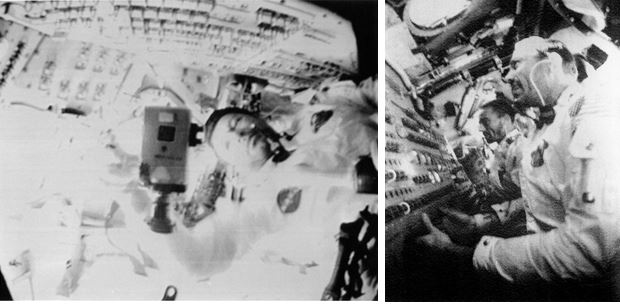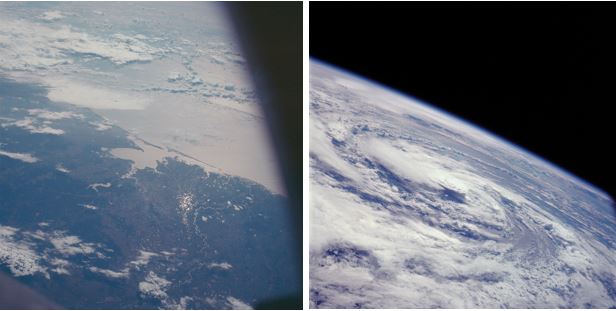Apollo 7 astronauts Walter M. Schirra, Jr., Donn F. Eisele, and R. Walter Cunningham continued their historic Earth orbital mission to thoroughly test the Apollo spacecraft and its systems. Throughout the flight, Mission Control passed up daily news reports to the crew, including updates on the Olympic Games taking place in Mexico City, and college and professional football game scores. One notable event that took place while they were in space was the wedding of Jacqueline Kennedy, widow of President John F. Kennedy, to Greek tycoon Aristotle Onassis.
They began their sixth day in space with the fourth burn of the Service Propulsion System (SPS). Eisele was at the controls of this test that lasted just 0.4 seconds. The main purpose of this burn was to test the minimum impulse capabilities of the engine. The burn changed the spacecraft’s orbit just slightly to 104 by 181 miles. Schirra likened the jolt from the short burn to a bump in an amusement park bumper car.
Shortly after the burn, which occurred over the United States, Eisele spotted the aircraft carrier USS Essex, their designated recovery ship. The Essex was conducting a recovery exercise about one thousand miles southeast from Florida when Eisele called down by radio and interrupted their carefully planned activities.
Shortly after the crew passed the midway point of their mission during Flight Day (FD) 6, they began to discuss plans for reentry. Although their colds seemed to be improving, all three still complained of stuffy ears and were concerned about their ability to clear them as the pressure in the capsule increased during the atmospheric entry. They suggested completing the entry with their suits on but their helmets and gloves off, allowing them to blow their noses to clear their ears. Flight surgeons and managers on the ground began discussing this proposal. This issue was discussed periodically for the remainder of the flight.
During the fourth TV broadcast at about 141 hours into the mission, Schirra, Eisele, and Cunningham gave another tour of their spacecraft, showing their couches, areas for loose stowage, their sleep stations, and their Hasselblad camera floating freely in weightlessness. During the 11-minute broadcast, they commented that movements in the capsule are easy, requiring very little effort. They added that there was no need for strong handholds, in fact they used their feet for anchoring themselves much more than their hands, which were then free to do their work.
During a pass over the United States at about 144 hours, the crew busied themselves with pointing various cameras out the spacecraft’s five windows. Passing still and film cameras back and forth and going from window to window to get the optimal views, Eisele commented that “it looked like squirrels in a cage.” Shortly after passing over Houston and capturing a view of their home town, they took several outstanding photographs of Hurricane Gladys churning in the northeastern Gulf of Mexico. Schirra described the hurricane as “a very spectacular view. There are a lot of broken clouds around the edges of it, but it tightens up in the center.”
Later during FD7, the crew prepared for the fifth and longest SPS burn of the mission, designed to test not only the engine performance during a long firing but also to verify the propellant usage monitoring system. The burn lasted 66 seconds and raised the high point of the spacecraft’s orbit to 280 miles while keeping the low point at 104 miles. During the last 30 seconds of the burn, Schirra took over control to demonstrate manual thrust vector control. He showed his excitement at the start of the burn with a jubilant “Yabba-dabba-doo!” in honor of Fred Flintstone of the cartoon television series. At the conclusion of the burn, Schirra commented “that was a real nice maneuver. The machine performed beautifully.”
A few hours after the SPS burn, Mission Control confirmed through tracking by the North American Aerospace Defense Command and the NASA Goddard Space Flight Center that the spent S-IVB second stage had reentered the Earth’s atmosphere during its 108th revolution and burned up. The reentry took place over the Indian Ocean, southeast of the Indian sub-continent. The S-IVB had been flying in a separate orbit since Apollo 7 departed from it after the rendezvous on FD2.
Prior to the fifth TV broadcast, Schirra made a prophetic comment that the crew was “going to try for an Emmy for the best weekly series.” Indeed, in 1969 the Apollo 7 crew received a special Emmy Award from the National Academy of Television Arts and Sciences for their TV broadcasts from space, the first from an American spacecraft. This broadcast, 189 hours into the mission, featured another spacecraft tour. Since the initial view was just of the crew couches, Schirra joked that the astronauts were out for a coffee break and that the spacecraft was flying itself. They began the tour by describing the spacecraft’s instrument panel including the attitude control thruster switches, the display keyboard for their onboard computer, and the cryogenic controls, and ended with the crew performing a mock military “close order drill.” This broadcast occurred on a Saturday morning, and all three TV networks preempted their cartoon shows to play the scenes from Apollo 7.
At the 190-hour and 55-minute mark, Apollo 7 surpassed Gemini 5’s time in space to become the second longest American spaceflight, a position it held until Apollo 15 in 1971. At this point they also passed the expected duration of a lunar landing mission, proving that the Apollo spacecraft and its crew could operate successfully for that length of time. Schirra, Eisele, and Cunningham had three more days in space to complete their test flight, with several more objectives to accomplish.





























